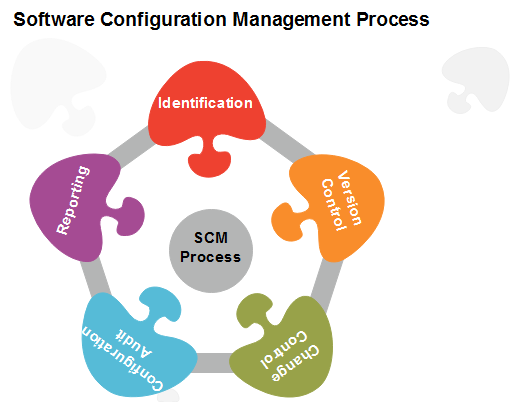SCM ProcessIt uses the tools which keep that the necessary change has been implemented adequately to the appropriate component. The SCM process defines a number of tasks:

Identification Basic Object: Unit of Text created by a software engineer during analysis, design, code, or test. Aggregate Object: A collection of essential objects and other aggregate objects. Design Specification is an aggregate object. Each object has a set of distinct characteristics that identify it uniquely: a name, a description, a list of resources, and a "realization." The interrelationships between configuration objects can be described with a Module Interconnection Language (MIL). Version Control Version Control combines procedures and tools to handle different version of configuration objects that are generated during the software process. Clemm defines version control in the context of SCM: Configuration management allows a user to specify the alternative configuration of the software system through the selection of appropriate versions. This is supported by associating attributes with each software version, and then allowing a configuration to be specified [and constructed] by describing the set of desired attributes. Change Control James Bach describes change control in the context of SCM is: Change Control is Vital. But the forces that make it essential also make it annoying. We worry about change because a small confusion in the code can create a big failure in the product. But it can also fix a significant failure or enable incredible new capabilities. We worry about change because a single rogue developer could sink the project, yet brilliant ideas originate in the mind of those rogues, and A burdensome change control process could effectively discourage them from doing creative work. A change request is submitted and calculated to assess technical merit; potential side effects, the overall impact on other configuration objects and system functions, and projected cost of the change. The results of the evaluations are presented as a change report, which is used by a change control authority (CCA) - a person or a group who makes a final decision on the status and priority of the change. The "check-in" and "check-out" process implements two necessary elements of change control-access control and synchronization control. Access Control governs which software engineers have the authority to access and modify a particular configuration object. Synchronization Control helps to ensure that parallel changes, performed by two different people, don't overwrite one another. Configuration Audit SCM audits to verify that the software product satisfies the baselines requirements and ensures that what is built and what is delivered. SCM audits also ensure that traceability is maintained between all CIs and that all work requests are associated with one or more CI modification. SCM audits are the "watchdogs" that ensures that the integrity of the project's scope is preserved. Status Reporting Configuration Status reporting (sometimes also called status accounting) providing accurate status and current configuration data to developers, testers, end users, customers and stakeholders through admin guides, user guides, FAQs, Release Notes, Installation Guide, Configuration Guide, etc.
Next TopicSoftware Quality Assurance
|
 For Videos Join Our Youtube Channel: Join Now
For Videos Join Our Youtube Channel: Join Now
Feedback
- Send your Feedback to [email protected]
Help Others, Please Share









